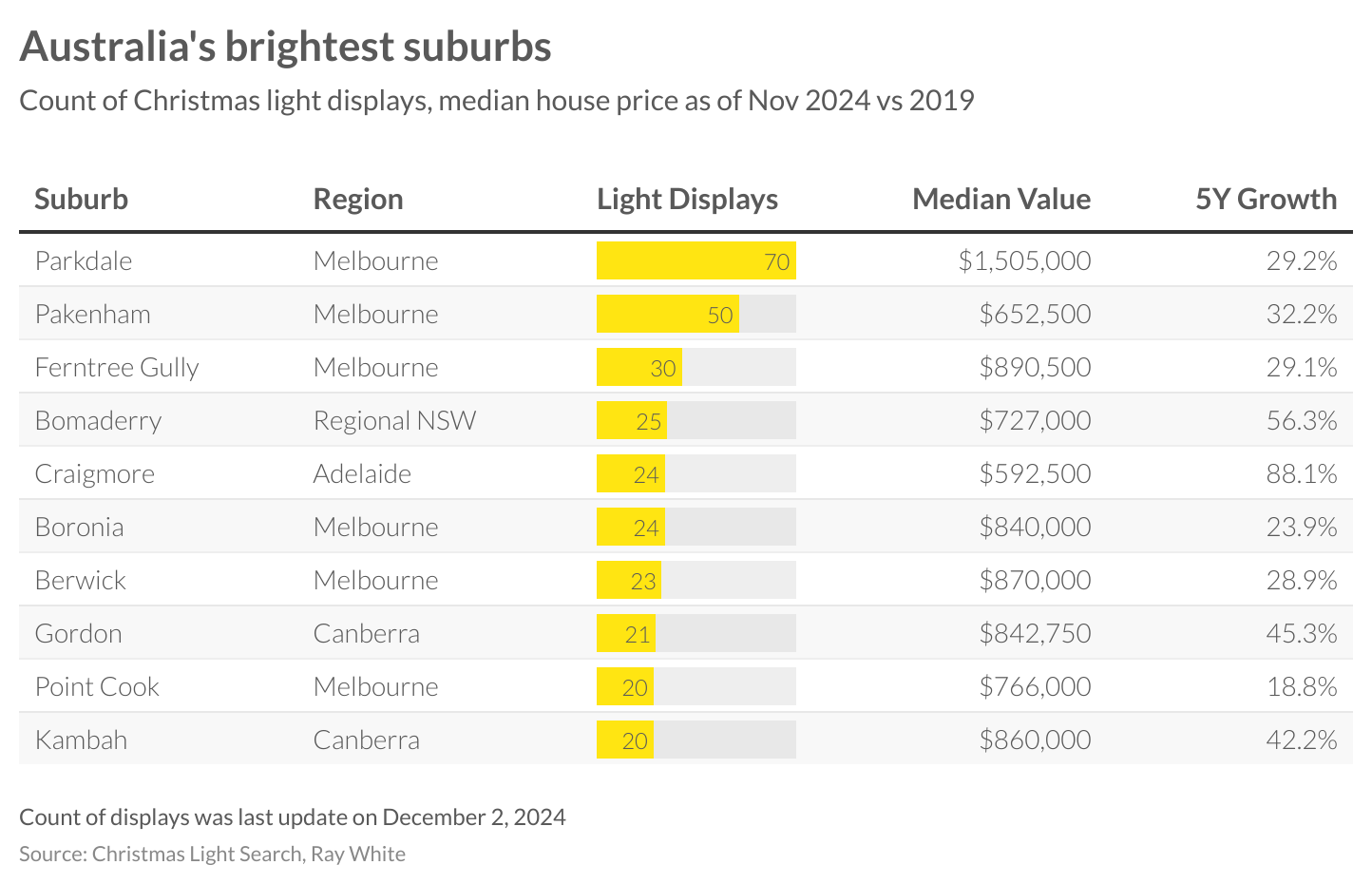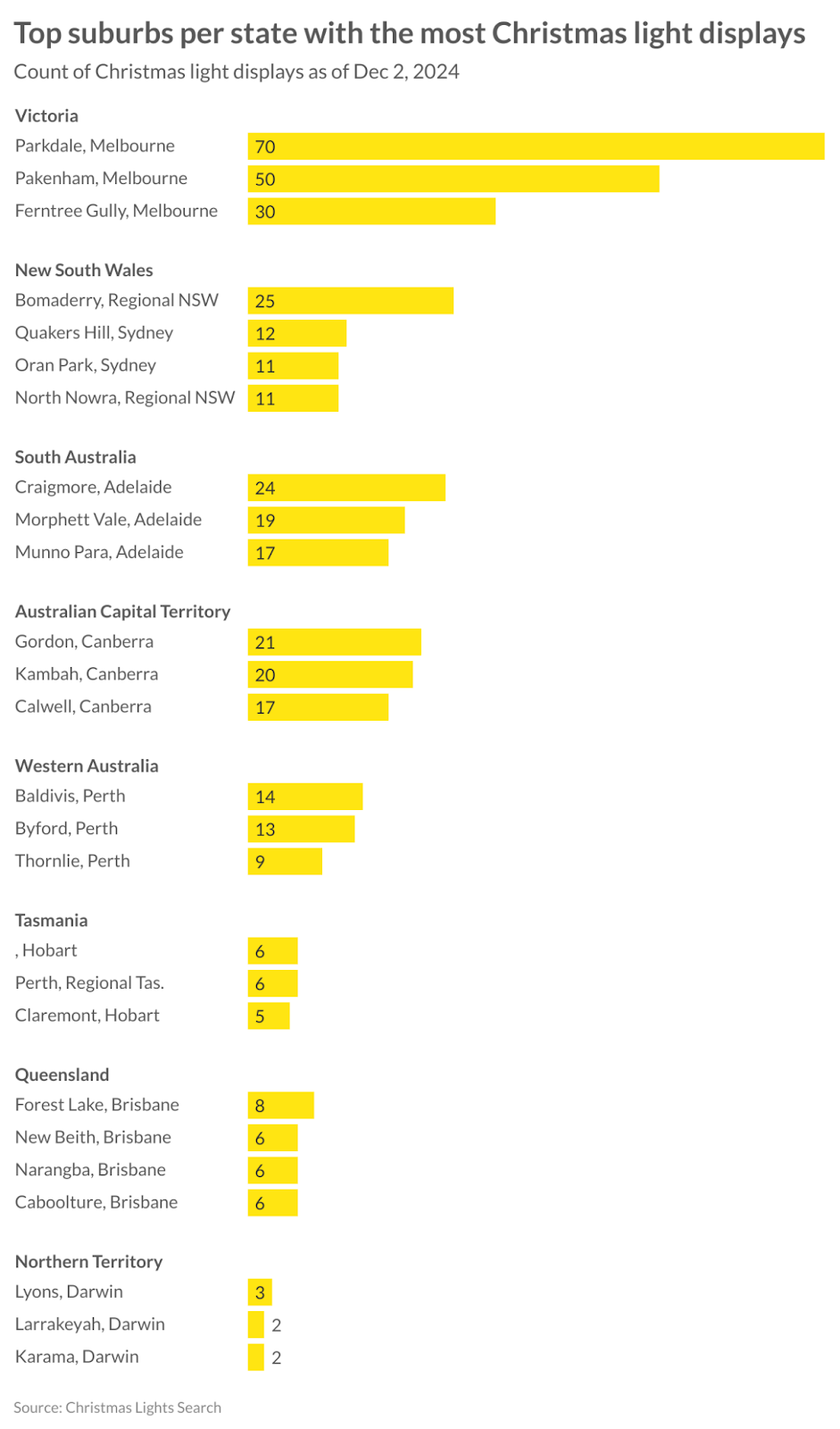Article Source: Click Here
Atom Go Tian
Ray White Group
Senior Data Analyst
Looking at Christmas lights is an annual tradition many Australians hold dear to their hearts. For many, it’s a core memory. Remember piling into the car in your pajamas to drive around with your family to see the neighbourhood’s best decorated homes?
Local councils and community groups often organise Christmas light competitions, even tours each year, turning neighborhood displays into major community events that draw visitors from across cities and regions.
This year, Melbourne is Australia’s Christmas lights capital, with an impressive 1,431 registered displays illuminating its suburbs. This dazzling figure is more than double that of Adelaide, which counts 700 festive installations. Sydney and Perth round out the top metropolitan areas with 518 and 400 displays respectively, while the festive spirit extends into regional communities, particularly in New South Wales, Victoria, and Queensland.
Melbourne’s festive dominance is further highlighted by its suburbs, with six of Australia’s top 10 most illuminated neighborhoods located in the Victorian capital. Leading the pack is Parkdale in Melbourne’s Inner South, where 70 displays create a concentrated wonderland of lights. The suburb’s popular viewing routes include Vialls Avenue, Keith Street, Mount View, Davey Street, Elliot Street and Cedric Street, all offering spectacular displays within close proximity.
Following Parkdale are Melbourne’s Pakenham and Ferntree Gully, with 50 and 30 displays respectively. Unlike Parkdale’s concentrated display areas, these suburbs feature decorations spread across numerous streets, making them ideal for evening drive-by viewing. This pattern of dispersed displays creates an extended Christmas light trail for visitors to enjoy.
Beyond Melbourne, several other suburbs have carved out their own festive niches. Bomaderry, in the Southern Highlands and Shoalhaven region, stands out as the only regional suburb in the top 10. Its displays, concentrated around Jasmine Drive, Sheraton Circuit, Banool Circuit, and Ferntree Drive, are all within walking distance, creating a perfect pedestrian-friendly Christmas light experience. Adelaide’s Craigmore has become known for its displays, particularly around Jenkins Court and Somerset Grove, while Canberra’s southern suburbs of Gordon and Kambah round out the top 10.

Surprisingly, these Christmas light hotspots challenged the common assumptions about festive displays and affluence. Of the top 10 suburbs, only Parkdale exceeds a median house price of $1 million, while five-year growth rates vary widely from 18.8 per cent to 88.1 per cent. Instead, the prevalence of Christmas light displays appears to be less about affluence and more about the perfect combination of space, community spirit, and family-friendly neighborhoods.
Outer suburbs typically feature more detached houses with larger frontages and gardens, providing the physical space needed for elaborate displays. In contrast, CBD-adjacent areas are dominated by apartments, townhouses, and heritage homes with limited display space.
Community characteristics also play a crucial role. Outer suburbs generally have a higher concentration of families with children and foster stronger neighborhood connections. This environment naturally encourages more street-level interaction between neighbors and often leads to friendly competition in holiday decorating, creating clusters of impressive displays.
The street layout of these suburbs plays a crucial role in their success as Christmas light destinations. Family-friendly street designs, particularly cul-de-sacs and courts like Jenkins Court in Craigmore (24 displays) and Jasmine Drive in Bomaderry (25 displays), create natural viewing hubs where visitors can safely gather and admire concentrated displays. These suburban planning features, predominantly found in outer areas, offer ideal conditions for community-centered light experiences and encourage pedestrian exploration.
The top suburbs from each state reinforces this outer-suburban trend across all states. In New South Wales, regional Bomaderry’s 25 displays are more than double those of metropolitan Quakers Hill (12 displays). Western Australia shows a similar pattern, with Perth’s outer ring dominating through Baldivis (14 displays), Byford (13 displays), and Thornlie (9 displays). This pattern extends to other capitals, with Adelaide’s northern suburbs of Craigmore, Morphett Vale (19 displays), and Munno Para (17 displays) forming a bright corridor of festive cheer.
These factors have transformed Australia’s outer suburbs into magical Christmas destinations where community spirit illuminates neighborhoods as brightly as the displays themselves, creating a modern tradition that bridges private celebration with public joy.

Data source: Street listings and display locations sourced from Christmas Light Search (christmaslightsearch.com.au), Australia’s leading directory of Christmas Light displays since 2008. The platform allows homeowners and community members to submit and update display locations throughout the festive season. This is a dynamic list as Christmas Light Search continuously gets added to daily, they may have additional displays beyond those cited here.
Download charts and image of Atom Go Tian here
Media contacts
Atom Go Tian
Ray White Group
Senior data analyst
agotian@raywhite.com
0422 089 938
Shannon Cook
Ray White Group
Senior media advisor
scook@raywhite.com
0437 593 050
Article Source: Click Here